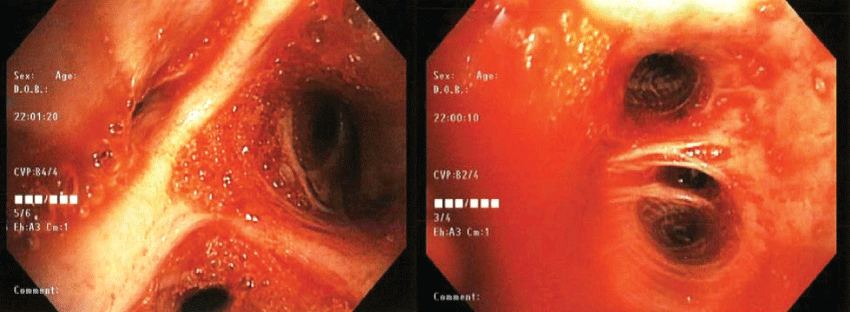Clinical Medical
Reviews and Case Reports
Pulmonary Alveolar Hemorrhage While on Dual Antiplatelet Therapy
Brian Grondahl*
Internal Medicine Resident, Michigan State University, Michigan, USA
*Corresponding author: Brian J Grondahl, Internal Medicine Resident, Michigan State University, East Lansing, Michigan, USA, E-mail: brian.grondahl@hc.msu.edu
Clin Med Rev Case Rep, CMRCR-3-118, (Volume 3, Issue 7), Case Report; ISSN: 2378-3656
Received: May 12, 2016 | Accepted: July 07, 2016 | Published: July 11, 2016
Citation: Grondahl B (2016) Pulmonary Alveolar Hemorrhage While on Dual Antiplatelet Therapy. Clin Med Rev Case Rep 3:118. 10.23937/2378-3656/1410118
Copyright: © 2016 Grondahl B. This is an open-access article distributed under the terms of the Creative Commons Attribution License, which permits unrestricted use, distribution, and reproduction in any medium, provided the original author and source are credited.
Introduction
Prasugrel is an anti-platelet agent in the thienopyridine class of adenosine diphosphate receptor inhibitors. It is commonly used in combination with low-dose aspirin as dual antiplatelet therapy (DAPT) in patients who have undergone percutaneous coronary intervention with stent placement. Prasugrel's use is associated with an overall low risk of bleeding (2.4% risk of major hemorrhage), but is avoided in the elderly and those with a low body mass index [1]. We present a rare case of diffuse alveolar hemorrhage associated with prasugrel use.
Case
The patient is a 48-year-old man with a past medical history of coronary artery disease and several stents placed over the last ten years, most recently a second generation drug eluting stent placed four years ago for acute myocardial infarction. He was on DAPT with 325 mg aspirin daily and prasugrel 10 mg daily. The patient had also been taking an additional dose of 325 mg aspirin daily for musculoskeletal pain. He was not taking any other non-steroidal medications. He presented with shortness of breath and hemoptysis. On examination, he was in acute respiratory distress and appeared uncomfortable. The patient was diaphoretic and coughing which produced hemorrhagic sputum with clots. Lung examination revealed tachypnea and bilateral crackles. His oxygen saturation was 89% on room air. Complete blood count and comprehensive metabolic panel were within normal limits. Chest imaging was within normal limits as well.
One unit of platelets was transfused. Aspirin and prasugrel were withheld. The patient underwent urgent bronchoscopy which showed large amounts of blood originating from the alveolar areas. A bronchoalveolar lavage was performed and sequential aliquots of instilled saline in the subsegmental bronchus were progressively more hemorrhagic. He was diagnosed with diffuse alveolar hemorrhage. The patient was subsequently monitored and stabilized within the next 24 hours. He had no further hemoptysis. He was discharged and advised to discontinue use of aspirin and prasugrel. Laboratory tests for vasculitic, infectious, and hypercoaguable causes of alveolar hemorrhage were unremarkable. The patient recovered uneventfully and did not have bleeding after reinstitution of low-dose aspirin at six month follow up (Figure 1 and Figure 2).
Discussion
This case highlights the need for clinician awareness of potential bleeding with novel anti-platelet agents and caution with concurrent use of normal doses of aspirin. Clinicians should consider diffuse alveolar hemorrhage as part of the differential diagnosis in patients on antiplatelet therapy who present with hypoxia and hemoptysis [2]. Only low-dose aspirin is recommended as part of DAPT [1,3]. Prasugrel has been associated with a major bleeding rate of 2.2% for all patients with increased risk among the elderly (age greater than 75) and in patients weighing less than 65 kg [1]. In patients with drug eluting stents, there is limited evidence of benefit for DAPT beyond one year, with decreased ischemic event rates at the risk of increased bleeding events [3,4]. Given this, current practice is to continue DAPT for at least one year after drug-eluting stent placement and to re-assess bleeding risk thereafter. The agent used for long term antiplatelet therapy is commonly clopidogrel, as it is associated with lowest bleeding risk [3].
This case illustrates the importance of following current recommendations of DAPT with low-dose aspirin for only one year following coronary stenting and low-dose aspirin thereafter to minimize bleeding risk. As this bleeding complication was likely exacerbated by aspirin use, patients also need to be counseled on the bleeding risks of excess aspirin and other medications that affect clotting (such as non-steroidal anti-inflammatory drugs) while on DAPT.
References
-
Wiviott SD, Braunwald E, McCabe CH, Montalescot G, Ruzyllo W, et al. (2007) Prasugrel versus Clopidogrel in Patients with Acute Coronary Syndromes. N Engl J Med 357: 2001-2015.
-
Collard HR, Schwarz MI (2004) Diffuse alveolar hemorrhage. Clin Chest Med 25: 583-592.
-
Mauri L, Kereiakes DJ, Yeh RW, Driscoll-Shempp P, Cutlip DE, et al. (2014) Twelve or 30 months of dual antiplatelet therapy after drug-eluting stents. N Engl J Med 371: 2155-2166.
-
Parker WA, Storey RF (2016) Long-term antiplatelet therapy following myocardial infarction: implications of PEGASUS-TIMI 54. Heart.







